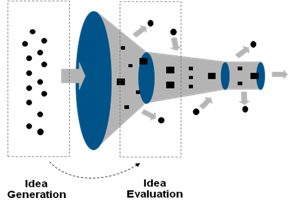By: Ehsan Ehsani
InnovationManagemenet is proud to present yet another experienced and knowledgeable columnist; Ehsan Ehsani, researcher and consultant in the area of innovation and product development. Ehsan is working with Accenture Product Innovation and PLM practice in New York City Office and has previous experience from a variety of firms both in Europe and the United States. This is the first in a series of columns starting off with a hot topic: Web-enabled open innovation.
This subject is particularly interesting to discuss as new web-based technologies are increasingly fueling the beginnings of what seems to be more distributed and collaborative approaches to design and creation processes. We seem to be living in the age of Wikipedias and innovation crowdsourcing. However, it’s still not clear to many companies how to organize a loosely connected community of contributors to design a new product or resolve a problem in an emergent way.
The use of web in innovation process is not new in the business world
The use of web in innovation process is not new in the business world: consumer goods and pharmaceutical companies such as Proctor & Gamble and Eli Lilly, as classic entrants, applied the concept to their innovation and product development process nearly a decade ago, and these models are now mainstream among many sectors such as consumer goods, high-tech and chemical products.
However, by taking a closer look at the experience of companies with web-enabled innovation, we realize that there are only few companies which are getting true financial value out of their initiatives and the real impact of many of such the initiatives has been minimal. Web-enabled open innovation, even though is widely recognized as an enabler for improving innovation performance is only practiced by few organizations (See Figure 1: Survey results). The success rate on the rest of the companies which were actually practicing web-enabled open innovation has also been rather low.

The success rate on the rest of the companies which were actually practicing web-enabled open innovation has also been rather low
Looking at the companies which have been successful in utilizing web-enabled open innovation, we realize that they do distinguish themselves in the way they approach the technology, though the full picture of what their best practices was not clear to us two years ago when we first started studying web-enabled innovation. This gap became a motivation for us to start a research initiative among several American and European universities to identify some of the lessons learned derived from the use of web for open innovation so far and the key factors differentiating best performers from the rest of the industry.
In addition to a global survey of more than 200 companies in 31 countries, we conducted numerous interviews and case studies in the companies which had adopted such practices to identify what was their degree of success and their experience with their open innovation initiatives.
While summarizing the result of our multi-year research in a short column series might not be possible, we’ll try to highlight some of our findings and lessons learned briefly in the current and upcoming post:
Lessons learned 1: One size doesn’t fit all
One of our early impressions which was later confirmed by our findings was that a probable reason for low success of web-enabled innovation is that many companies have taken the success story of the pioneering firms with open innovation as gospel and have jumped into this space with the assumption that same solution will work for them too. As the result, many initiatives have been launched for the sake of “going open innovation” rather than companies’ needs.
However, one key element which should be always kept in mind when formulating web open innovation strategy is that collaboration in virtual space has to be carefully crafted around three main areas in alignment with company’s needs:
- Project Openness: The collaborative nature of new web applications (especially ones called web 2.0) and the fact that they break the boundaries of the physical workplace makes it possible for a distributed group of people, possibly from different organizations, to work together in a more open way. However, the degree of openness should be adjusted based on the nature of the projects that the company is conducting. A company such as Kraft might decide to open up the challenge of new package design to the whole world as the crowd input is easy to evaluate and the general audience have the capacity to solve the issue. Another company like Novartis might prefer to approach a selected community in the web to solve its drug discovery process issues.
- Governance model: The definition of rules and working hierarchies among people to conduct activities within the web space is also a key theme. In Wikipedia, where the tendency is towards openness, groups of people create shared property or common ground where it is in everyone’s interest to create a positive outcome. In such environments, a hierarchy (if one exists at all) is defined collectively by the group. On the other hand, more traditional structures similar to those in the real world can also be utilized, where the problem as well as the feedback process and rules are defined by one entity. InnoCentive is an example of this governance mode as the process in which companies and solvers should go through is rather standard.
- Incentive processes: Transparency over the activities conducted by others might be utilized to develop new incentive schemes for web collaboration. Open Source Communities have long been using this type of incentive as programmers contribute to the development of software for obtaining status among their peers. Traditional monetary ways for encouraging individuals or groups is also another way to bring outsiders to solve company’s challenges. HP Labs website does so by financing researchers in the areas desired by the firm. There is no optimum choice as this area should be aligned with the nature of problemscompany is facing and its business strategy.
Looking at the results a multi-year research conducted by industry and a group of European and U.S. universities among more than 200 global companies; we realized that pioneers in this area pay special attention to a series of factors in organizing their web-enabled open innovation efforts. Lessons learned derived from experiences of such companies can provide valuable insights for the ones who want to enter this area.
I will share some more insights derived from our research:
Lessons learned 2: Identify the critical piece of the chain and focus on it
Product Innovation as a process is not only limited to the activities involved in idea management or developing a new concept for a product: The process virtually covers all the activities throughout a product lifecycle, from the inception of the idea till the moment product is offered in the market and/or service after sales is offered to the customers.
Consequently, web-enabled open innovation has found its way to these activities and different models of collaboration with externals are being utilized for each stage of the product lifecycle (See Figure 2 – Click on image for larger view).
Figure 2: Use of web-enabled open innovation in different stages of product lifecycle.
During our research studies, we were curious to see the distribution of companies using web-enabled open innovation in each stage of product lifecycle. We were particularly interested to know if companies have a tendency to use web-technologies in one stage of the innovation process more than others.
…there is a tremendous tendency among many companies to use web-enabled open innovation in the early stages…
After looking at the information derived from our sample companies under study, we realized that there is a tremendous tendency among many companies to use web-enabled open innovation in the early stages of innovation process namely idea and concept generation while many other innovation activities and stages of product lifecycle were neglected.
Find the critical link
At the same time, we noticed that companies which have been successful in the use of web-enabled innovation have taken a different approach and here was when we found out about the second lessons learned: Instead of going with the crowd and focusing on typical applications of web-enabled innovation, pioneers tried to identify where the critical link in the product lifecycle is and focused on using the technology to strengthen that piece of the value chain.
For a company like Google, which is developing numerous applications and products in a short period of time, it is crucial to identify errors and enhancement opportunities quickly so that the products can function flawlessly and in line with customer requirements. Therefore, Google relies heavily on its platform called “Google Labs” so that external developers can provide suitable feedbacks and enhancements applications for its products under development.
Developed products with a low level of complexity are tested by customers online via a web-page. Google also launches some of its products in the preliminary stage or “Beta Version” to the public so that customer can comment and give feedbacks on the potential bugs or enhancement opportunities. However, Google is rarely using idea generation portals or other mechanisms for online ideation as those are less challenging areas for the company.
Which ideas are the true golden nuggets?
I remember a conversation with a European Innovation Director in a global health and body care company where I was told: “At the moment the processes for idea generation and getting consumer insights for the new products all around Europe are working properly; we are getting lots of different ideas from the market through different channels, but our challenge is to identify which ideas are the ones customer value the most…[the act of] prioritizing thousands of ideas we receive and focusing on truly valuable ones is quite a difficult task”.

Figure 3: Refocusing web-enabled innovation from idea generation to idea evaluation in a consumer goods company.
The above mentioned consumer goods company, therefore, started a new initiative to engage consumers through different online platforms to comment on their preferences, value perceived and priorities. The new online initiative helped the firm to find a new powerful lever to prioritize the large pool of ideas in hand and move forward with the most promising ones.
I don’t intend to make this column longer than this therefore, leave the rest for the next month: In the next column I will discuss the disruptive nature of web-technology and its potential to substitute traditional ways of conducting innovation activities.
Till then, let us know what you think!
 About Ehsan Ehsani
About Ehsan Ehsani
Ehsan Ehsani is a researcher and consultant in the area of innovation and product development. Working with Accenture Product Innovation and PLM practice in New York City Office, he has consulted and worked with a variety of firms including ExxonMobil, Diageo, Sara Lee, Henkel, Unilever, UPM-Kymmene, Ericsson, SKF, Telefonica, Repsol, Abertis Telecom and Lego. He can be reached at Ehsan.ehsani@accenture.com


